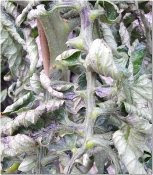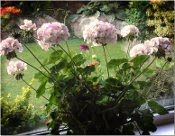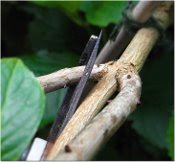 This rose bush has hardly been touched since you saw a bottom leaf in a posting on 24th June, except I have sprayed it once more and removed one or two of the lower leaves.
This rose bush has hardly been touched since you saw a bottom leaf in a posting on 24th June, except I have sprayed it once more and removed one or two of the lower leaves.As you can see, the problem has been almost contained, probably by the 'Dithane'. Although one or two of the lower leaves are infected (the yellow ones), the rest of the plant is healthy and has flowered well (it is between flower flushes at the moment).
I mentioned previously that this disease (caused by a fungus) usually first appears on the lower leaves, which tend to be darker and damper and are closer to the soil where the disease over-winters. This bush is in a particularly dark and damp spot (next to the problem hosta).
Apart from removing infected leaves and spraying with a good fungicide at the first sign of disease (this is important so it is contained before it has got too great a hold), I have two strategies:
- good hygiene
- cultural control
GOOD HYGIENE
- When disbudding, best to deal with diseased plants last, always starting with clean plants.
- If it is necessary to touch infected part of the plant - to remove diseased leaves, for example - disinfect your hands and tools immediately to avoid contaminating clean plants. I usually spray both with kitchen bleach, then rinse after a few seconds and allow to dry. A candle flame, or similar, will sterilise a blade.
- Spray soil as well as underneath lower leaves. Just a light misting is enough so fungicide does not travel too far into soil where it can affect soil fungal microorganisms.
- Inspect new plants carefully to ensure they do not carry disease.
- Propagate as much stuff yourself to avoid bringing in pests diseases.
- Do not take cuttings from plants that have been recently infected.
CULTURAL CONTROL
Fungal disease likes constantly damp conditions. Therefore:
- Carefully remove infected leaves and burn, if possible.
- Try to avoid planting in shade. Some sun during the day is beneficial.
- Some say that a bark mulch around the plants helps, since it reduces soil splash. I have never tried it.
- Keep the bush as open as possible by cutting to outward-facing buds when pruning. Thin out if necessary. This lets drying air pass through.
- Keep plants adequately fed to maintain their resistance, but not exceptionally so. High potassium feeds (eg rose feed) can harden the plants against disease.
- Ensure plants do not touch each other, to avoid spreading pests and diseases (thin out if necessary). In larger beds, make sure you can walk between them easily, avoiding brushing against leaves, so infection is not spread on clothing.
- Avoid wetting leaves of infected plants when applying water. Apply water around roots only.
- Spray at night when insects are resting and leaf will not dry out too quickly (allows time for fungicide to enter plant). Ensure spray covers underside of leaves where pores are. Only apply enough spray to form a light mist, avoiding run-off.
- Choose plants with dark green glossy leaves.
- Yellow-flowered plants seem to be more susceptible.
- Spray with fungicide in late winter just as buds are breaking.
- Prune hard back to cut out as much diseased wood as possible.


















